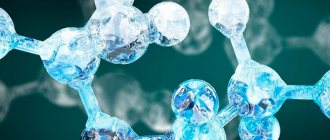Atopic dermatitis is a chronic skin disease. Due to disruption of biochemical processes, excessive dryness, peeling, redness occurs, inflammatory processes develop, and itching is felt. It develops under the influence of allergens, and is often combined with bronchial asthma, food allergies, and allergic rhinitis. It appears in the first years of life, most often before 12 months or at the age of 2-3 years, when the children's diet expands and many allergenic foods enter it. With proper treatment and care, the disease enters the stage of stable, long-term remission, but can manifest itself in adolescents, young and elderly people during contact with allergens, a weakened immune system, and after stress.
Symptoms
With atopic dermatitis in children, skin tightness, redness appears, the skin flakes, feels rougher to the touch, and thickening may appear. Microscopic bubbles form, around which moisture is released. The child is worried and scratches the affected areas. When an infection occurs, local inflammation develops and the wounds heal poorly. With significant spread in young children, general intoxication of the body manifests itself: the temperature rises, the peripheral lymph nodes enlarge. Due to severe itching, sleep and appetite are disrupted, and the child often cries. Dermatitis most often affects the face, neck, armpits, scalp, groin, areas under the earlobes, popliteal fossae, and elbows.
How to recognize allergic contact dermatitis in a child
The contours of the inflammation often coincide with the outlines of the object that caused the irritation. The rash spreads little beyond the area of skin that came into contact with the causative factor. The skin here becomes red and swollen, very itchy, blisters, wounds and crusts appear.
Fungal and bacterial infections easily attach to wounds and suppuration occurs. Babies may experience an increase in general temperature.
Frequent exacerbation in the same places leads to unpleasant outcomes: areas of increased or decreased pigmentation, scars, thickening and roughening of the skin.
If you notice a rash or red spots on your child’s skin, be sure to see a doctor to get tests done to determine the exact cause and begin treatment.
The disease may worsen. To prevent this from happening, you need to find and eliminate the provoking causes.
Prevention
Atopy is translated from Latin as strangeness. The causes of the disease cannot always be determined. But long-term observation of patients and members of their families has revealed that it develops more often:
- with a genetic predisposition - if the parents are healthy, the probability of developing dermatitis in the child is 20%, if one of them is sick - 50%, if both are sick - 80%;
- in case of unfavorable pregnancy, active or passive smoking of the expectant mother, consumption of food that provokes allergy attacks, use of certain medications;
- when a newborn is in a dusty room, insufficient care for his personal hygiene;
- with prolonged exposure to allergens that enter the child’s body with food through the respiratory tract.
Breastfeeding for up to 6 months and avoiding allergy-provoking foods reduces the likelihood of developing atopic dermatitis.
Types of urticaria
There are two forms of the disease: acute and chronic. Acute urticaria is often caused by food allergies, insect bites, medications, or exposure to an allergen. It lasts, as a rule, up to 1.5 months.
Chronic urticaria lasts more than 6 weeks. It can begin when the immune system attacks the body's tissues, thereby causing an autoimmune reaction. Antibodies (proteins that normally fight bacteria and viruses) cause the release of histamine, which leads to lesions on the skin.
The rash can be localized or appear anywhere on the body, from the neck to the knees. Rarely does the allergy affect the arms, legs and face, unlike angioedema. Characterized by the appearance of rashes and spots on the skin. There is also swelling in the eyelids, lips and larynx.
Angioedema urticaria is a medical emergency because it can cause breathing problems and suffocation.
It is believed that 30 to 50% of cases with chronic urticaria have an autoimmune cause. The reason why autoimmune urticaria develops is unknown, even though it often occurs along with other autoimmune diseases such as:
- rheumatoid arthritis – the immune system attacks the joints;
- lupus – the immune system attacks the joints and skin.
In rare cases, chronic hives can also be caused by other infections (eg Helicobacter), hyperthyroidism (overactive thyroid), hepatitis B or C (liver infections), intestinal parasites.
Table - Types of urticaria in children
| Name | Peculiarities |
| Immune (IgE-dependent - food, drug, helminth; complement components - anaphylotoxins C3a and C5a; complement-induced - hereditary or acquired deficiency of the C-1q inactivator) | Characterized by skin damage and itching. Quincke's edema, urticarial type of vasculitis and anaphylactoid urticarial reaction are possible. |
| Non-immune (based on a pseudo-allergic reaction) | There is no true reaction of interaction between antibody and antigen with the formation of an immune complex. Ig-E does not increase. Occurs due to consumption of foods that contain vasoactive amines. |
| Pigmented | Accompanied by an increase in the number of mast cells. Often found on the upper and lower extremities or trunk. May damage internal organs and be accompanied by systemic mastocytosis. |
| Vascular urticaria or vasculitis | It is characterized by several lesions that have an unusual shape and disappear after a few days. Other symptoms of urticaria vasculitis include fever, joint and muscle discomfort, abdominal pain and headache. |
What to feed a child with atopic dermatitis
In order not to provoke an exacerbation of dermatitis, to relieve itching and redness of the skin, you need to follow a diet. Foods that burden the immune system are excluded from the children's diet: citrus fruits, chocolate, eggs, honey, seafood. Red (strawberries, cherries, currants, apples) and exotic (mangoes, coconuts, pineapples) fruits are dangerous.
Split meals are recommended: small portions every 3-4 hours. It is better to boil, stew, bake, but not fry. Do not use spices, black pepper. The diet should be balanced and contain enough protein, vitamins, and microelements.
Avoid giving your child sugary carbonated drinks, chips, crackers and other snacks for as long as possible. If the infant is receiving breast milk, introduce new foods carefully. Add the product once a week to make sure it doesn't cause breakouts. After meals and between meals, offer your baby clean boiled water.
Skin care
To relieve itching and prevent infection of the affected skin, you need to properly care for your skin:
- It’s better not to take a shower, but to take a cool bath for about 10 minutes; use medicated bathing products with a soft base that cleanse but do not dry the skin;
- moisturizing and softening – the skin should not be dry to prevent flaking and cracking; regularly apply a moisturizer recommended by a dermatologist;
- Do not let your child scratch the affected areas to avoid infection - apply anti-itching products to the atopic areas.
Cream or gel relieves discomfort during an exacerbation and allows you to sleep, eat, and play peacefully. Apply the drug to cleansed skin, treat atopic lesions and the areas around them. Do not exceed the recommended dosage and frequency of use.
Treatment of urticaria
Pharmaceutical drugs used to treat urticaria should be taken as recommended by your doctor. The best treatment for this condition is to know and avoid trigger factors. The hives will probably go away on their own. But at the same time, medical supervision is a prerequisite to exclude the development of complications.
Treatment for urticaria in children includes:
- taking antihistamines to reduce the rash;
- eliminating foods that cause hives;
- prescribing diuretics to eliminate severe edema;
- using antipruritic ointments to relieve the condition.
- in some situations, hormones are used (topically and by injection).
You need to keep a diary about what the child does and eats. This approach allows us to identify predisposing factors and eliminate them.
Gradually, one can narrow down the real causes and respond accordingly.
With such a complication as Quincke's edema, coughing attacks appear and breathing becomes difficult. In this case, urticaria in children requires emergency care.
Young children often experience swelling of the gastrointestinal mucosa, which is accompanied by vomiting. In severe cases, damage to the nervous system and brain occurs. Such conditions are dangerous to health and life, so delaying a visit to the doctor is unacceptable.
Most children switched to a hypoallergenic diet recover quickly and recover even without medication.
Rating of the best remedies for atopic dermatitis
To treat atopic dermatitis, use special children's products recommended by a dermatologist. During exacerbations, medications are prescribed for oral administration, application to atopic areas and general body care:
- preparations for removing allergens from the body - Enterosgel, Lactrofiltrum, Enterodes;
- skin softening products – Atopic cream for daily care;
- drugs that relieve itching - Panthenol spray;
- bathing products - soft shower gels for atopic dermatitis should be purchased at the pharmacy: dermatologists recommend using Atopic bathing gel from head to toe.
Prices
| Name of service (price list incomplete) | Price |
| Appointment (examination, consultation) with an allergist-immunologist, primary, therapeutic and diagnostic, outpatient | 1750 rub. |
| Prescription of treatment regimen (for up to 1 month) | 1800 rub. |
| Consultation (interpretation) with analyzes from third parties | 2250 rub. |
| Consultation with a candidate of medical sciences | 2500 rub. |
| Allergen-specific immunotherapy (ASIT) - maintenance course (excluding the cost of the drug) | 8100 rub. |
Bathing
After a light shower to thoroughly cleanse your entire body, apply Atopic Bathing Gel to damp skin from head to toe, massage lightly and rinse thoroughly. Dry your baby with a soft towel using blotting, but not rubbing, movements. After water treatments, apply Atopic skin softening cream for daily care. Apply it several times throughout the day: after washing your hands and washing your face.
When taking a bath, the water temperature should not exceed 36 degrees. Place your child in the water and offer him toys or other entertainment. After 5-7 minutes, apply Atopic Bathing Gel from head to toe and rinse well. After bathing, use Atopic cream for daily care, and if itching bothers you, let the cream absorb, and then treat the affected skin with an anti-itching drug.
How to choose products that are right for your child
A dermatologist may recommend not one, but several drugs to choose from. They have a similar mechanism of action, but their prices may differ significantly. It depends on the active and auxiliary substances, manufacturer, and release form. When choosing a cream for a child’s atopic skin, you need to take into account possible individual intolerance to individual components.
You need to purchase drugs from well-known manufacturers with a good reputation: Russian, European, American. It is equally important to contact large pharmacy chains that work directly with manufacturers and control the quality of drugs on sale - this will protect you from purchasing counterfeit drugs. Consider the age of the child: choose creams and gels with a pleasant smell so that the child enjoys going to the shower.v
When choosing drugs for oral administration, it is preferable to buy syrups, powders, drops, rather than tablets and capsules that are difficult for a child to swallow.
Diagnostic methods
When this disease develops, the patient or his parents are interviewed and the symptoms are analyzed.
The doctor can make a preliminary diagnosis after examining the child’s skin. A rash with urticaria is difficult to confuse with another. However, to exclude errors and establish the cause, tests are prescribed:
- stool analysis, which will help identify parasites - they can be pathogens;
- general blood test - identifies or excludes inflammatory and immune processes;
- allergy tests - skin tests to identify the pathogen;
- liver tests - to determine liver function and exclude its pathologies.
Thyroid function may be tested because the disease can be caused by hypo- or hyperthyroidism.









